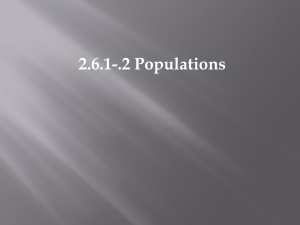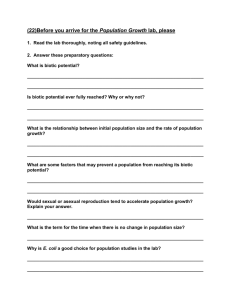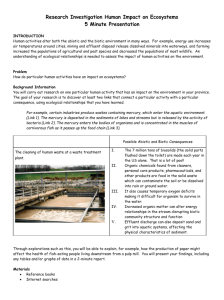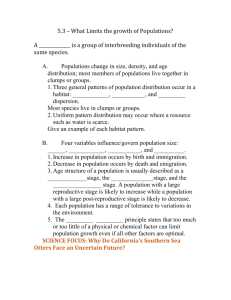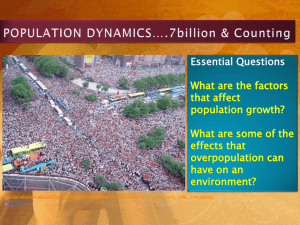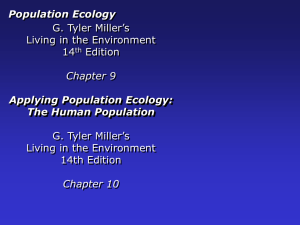population dynamics
advertisement
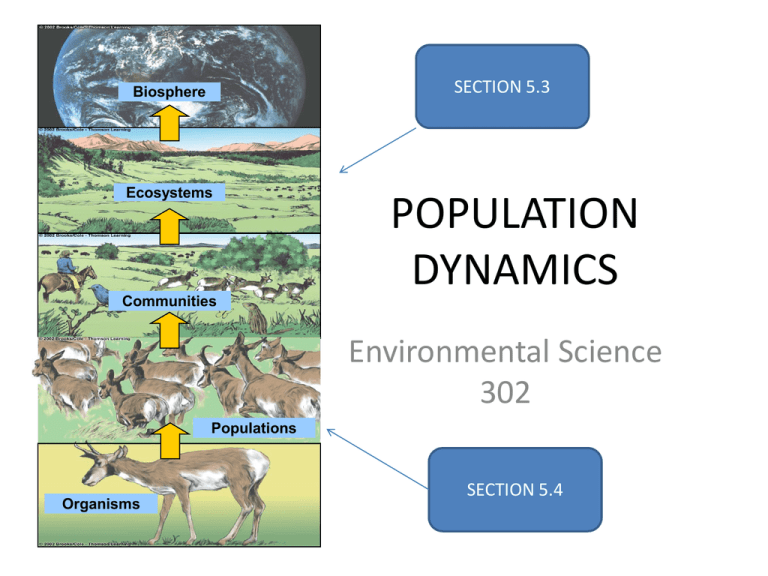
SECTION 5.3 Biosphere Biosphere Ecosystems Communities POPULATION DYNAMICS Environmental Science 302 Populations Organisms SECTION 5.4 • What makes you stressed out? • What do you do when you’re stressed out? • Is this a positive feedback loop or a negative feedback loop? • Do your actions make the problem worse or do you feel better? • In the end, though, don’t you recover? • THIS IS STABILITY / What about major disturbances? • Can be natural disasters or caused by humans • Some examples… • Either can be Catastrophic quick & painful or Gradual slow & building • Some examples… • What is climate change considered? II. A. STABILITY • An ecosystem deals with these disturbances • INERTIA a body in motion will stay in motion • Aka: persistence ability of a system to resist being disturbed or disrupted • Your examples… • CONSTANCY stay the course; ability to maintain a certain size population • Your examples… • RESILIENCE ability to bounce back • Your examples… Free write • Choose a population of plant or animal • Write how they exhibit INERTIA in the face of change (look at your notes: can be natural or human-caused). • Write how they exhibit CONSTANCY in the face of change • Write how they exhibit RESILIENCE in the face of change. • I will call on you to share! II. B. There is a breaking point… • How do we know when an ecosystem is REALLY in trouble? – Drop in PP (autotrophs leave) – Nutrient loss – Indicator species decrease – A lot of pests or disease organisms – Decrease in species diversity (food webs are shrinking) – Contaminants are present III. Sometimes we notice things too late…TIME DELAYS • Just like it takes several years for lung cancer to develop in a smoker… – quitting smoking is often an ineffective negative feedback action • Depletion of the ozone layer, introduction of toxins, industrial emissions all take time to show their effects • A proposed negative feedback action for global climate change is to plant more trees – why? Do you think it’s too late? IV. Synergy • Occurs when the sum is greater than its parts • Example – 2 people working together to move a log that neither could move on their own V. Diversity is Good! • Biodiversity is Nature’s Insurance Policy • Don’t put all of your eggs in one basket • In the next picture, what happens if the carnivorous zooplankton is stricken with a deadly virus? • What happens if dissolved oxygen decreases just enough to kill all benthic invertebrates? Putting it together… • How diverse is diverse enough? How do things still go wrong? What’s the breaking point? • RAINFOREST ecosystems: – (H) diversity, (H) inertia/resistance, (L) resilience • GRASSLAND ecosystems: – (L) diversity, (L) inertia, (H) resilience • Everything is unique and constantly changing VI. Species Equilibrium Model • The “Island” Model: Immigration & Extinction determine who lives there • Depending on size (big vs. small) and distance from others, the ecosystem might get a lot of new immigrants (can they find it?) or species could die (is it too small/too much competition?) Conservation Biologists • How big should nature reserves be to provide adequate “islands” with enough resources for species? • Example: – A Grizzly needs ~ 400 mi2 – A pop of 90 would need 36,000 mi2 – Yellowstone NP ~ 21, 000 mi2 Island Biogeography Sec 5.4 POPULATION DYNAMICS • To understand ecosystems fully, we need to understand the populations that make it up. • Biotic potential versus environmental resistance • Growth curves • Density dependence and critical number Biosphere Biosphere Ecosystems Communities Populations Organisms I. A. • • • • • Population Dynamics Populations differ by: Size Density Dispersion (spacing) Age distribution • • • • Populations change by: Births Deaths Immigrations – Coming in • Emigrations – Leaving Population Equilibrium Population change = (births + immigration) – (deaths + emigration) Births Deaths I. B. What determines the existence of a population? • 2 opposing forces • BIOTIC POTENTIAL focus is on increasing the organism – How much of yourself can you make? • ENVIRONMENTAL RESISTANCE focus is on limiting the organism – How well can you survive? • Populations strive to find a balance • Different strategies are used to survive I. B. 2 BIOTIC POTENTIAL • R = biotic (reproductive) potential • The maximum rate at which a pop could grow if it had unlimited resources • CHARACTERIZED BY: – Early reproductive age – Short generation times – Reproduce many times – Produce many offspring during each event I. B. 3 ENVIRONMENTAL RESISTANCE • No matter what your capabilities, the environment must support your needs • K = carrying capacity – The number of individuals that can be sustained indefinitely in an area Label if each is an example of BIOTIC POTENTIAL or ENVIRONMENTAL RESISTANCE • Adverse weather conditions • Predators • Defense mechanisms • Competitors • Ability to cope with weather conditions • Reproductive rate • • • • • • • • BIOTIC POTENTIAL Ability to cope… Defense mechanisms Reproductive rate ENV’RNMTL RESISTNC Adverse weather Predators Competitors GRAPHING POPULATION GROWTH • J- shaped growth young populations will grow exponentially at first. Times are good! • Eventually, environment resists – (too crowded, not enough resources) • TWO CHOICES: stabilize or crash (dieback) • S- shaped curve = stabilizes at carrying capacity – May not be smooth (time-lag) I. C. Carrying Capacity can Vary • Fluctuates depending upon: – Competition among and between species – Immigration & emigration – Natural & human-caused catastrophes – Food, water, hiding, nesting places • Just as there is a max (K), there is also a minimum the critical number = the lowest population level for survival and recovery Who wins? Get out of my way! • How a population responds to environmental resistance can depend on how crowded it is. • DENSITY DEPENDENCE • Compete for resources, subject to predation, parasitism & disease • DENSITY INDEPENDENCE • Everyone has an equal chance of dying, regardless of population size: – ex: natural disasters Who wins? Multiply or Survive • There are advantages & disadvantages to each strategy but populations tend to be: • r-Strategists focused on reproduction • K-Strategists focused on surviving at K r- Strategist • • • • • • • • • • • Many, small offspring little/no parental care Early reproductive age Most offspring die before reproducing Small adults Adapted to unstable enviro High population growth rate Erratic graph/not at K Generalist Not a good competitor Early successionist K- Strategist • • • • • • • • • • • Few, large offspring High parental protection Late reproductive age Most offspring reproduce Large adults Adapted to stable enviro Low pop growth rate Stable, S-graph around K Specialist Good competitor Late successionist Which strategy is most successful? • In the “next life” you can be any other organism aside from human. What strategy would you choose to be? An r-strategist or a K-strategist? 1. Write three benefits supporting your choice. Don’t just re-write characteristics – why are they good!? IMAGINE A DISTURBANCE 2. Explain two drawbacks of the other strategy in this situation – write specific examples of why it would be a disadvantage 3. Write two drawbacks that you will face with your chosen strategy in this disaster Extra slides Define: homeostasis. Define: dynamic Are these opposite terms or can they both exist at once? Are disturbances bad or good? For whom? What are the two fundamental kinds of population growth curves? What are the causes and consequences of each? • The two types of population growth curves are the J-curve and the Scurve. “The J-curve demonstrates population growth under optimal conditions, with no restraints. The S-curve shows a population at equilibrium.” The J-curve is caused by exponential growth of a population and the absence of mechanisms to cause the population to level off; the consequence of this type of growth is a population crash and a reduction in the carrying capacity. The S-curve is caused by exponential growth of a population until natural mechanisms cause the population to level off and continue in a dynamic equilibrium. The causes of this type of growth are the various biotic and abiotic factors that limit a population’s increase (environmental resistance).” • No one anticipated the following results from the reintroduction of wolves to Yellowstone. Changes included increased riparian habitat plant diversity (elk, to protect themselves from wolves, spend less time along rivers and more time in the trees), increased song bird numbers and type (elk no longer trample riparian plants and bird habitats have returned), and increased raptor numbers (wolves have decreased coyote population resulting in the rodents increasing, providing raptors with more food).



